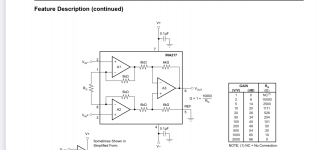I am using a laplace anti riaa to feed the riaa circuit so it results in a flat responce.Andreas, I think U1 and U2 supply that. The feedback loop keeps the bottom of the emitter resistors at the voltage to support the right Q1, Q2 collector current versus the 5V ref.
But wasn't this supposed to be an (anti) RIAA? As I see it, it has a flat freq response.
Jan
Andreas, I think U1 and U2 supply that. The feedback loop keeps the bottom of the emitter resistors at the voltage to support the right Q1, Q2 collector current versus the 5V ref.
But wasn't this supposed to be an (anti) RIAA? As I see it, it has a flat freq response.
Jan
Jan, this is not an anti RIAA. It is an MC RIAA. You have quite high resistor values in the passive RIAA. Do they affect the noise ? I also think I like the current source version better.
I have another version where i use even higher value resistors for the riaa filter...... no noise penalties
I do not like the idea to supply transistor currents via opamp output.
Free and independent choice of operating currents is preferred.
That sounds like a strictly personal opinion. Which is OK.
But it's just what feedback loops do, set the currents and/or voltage to what you have decided they should be.
The 5V ref and the collector current can be precisely selected to set the currents in the circuit. Quite elegant I would say. 😎
Jan
Last edited:
Feedback should set signal conditions.
If you want to establish operating points by fb it is also possible - but
I think it is better to do it independently.
In the circuit of post 11333 you can change gain only by changing R3 -
and you have dc on the output in most cases. I consider this a drawback.
Also, it may be easier to establish a low noise current source compared
to voltage source V5.
If you want to establish operating points by fb it is also possible - but
I think it is better to do it independently.
In the circuit of post 11333 you can change gain only by changing R3 -
and you have dc on the output in most cases. I consider this a drawback.
Also, it may be easier to establish a low noise current source compared
to voltage source V5.
Feedback should set signal conditions. Tell that to every power amp designer you know (except NP ;-). As I said, a strictly personal opinion. MMMV. 😎
Jan
Jan
Here are the files....
Very nice.
And may I offer R27 and R28 {10k/3}
Very nice.
And may I offer R27 and R28 {10k/3}
Hello Frans.... good to have you here... would you care to explain your modification?
Compare the operational currents at R26 and R27, you will see 🙂
Now I understand
Thank you so much 🙂
Thank you. I just came to the Hotel. Ist is easy to servo the INA. That way you can get rid of the coupling Caps.
Look here for a similar Cohen design, using THAT1240 and very low noise input transistors.
A Low Noise Balanced Input Moving Coil Preamp Using the ZTX851 - Page 49 - Pro Audio Design Forum
Hans
A Low Noise Balanced Input Moving Coil Preamp Using the ZTX851 - Page 49 - Pro Audio Design Forum
Hans
Last edited:
The simplest balanced low noise, discrete/opa hybrid is the Graham Cohen double balanced mic pre arrangement. The first opamps FB resistors bias the
IP devices. I've forgotten how many Pro Mic Pre's with variations of this circuit have been on the bench.
Original paper:
https://www.google.com/url?sa=t&rct...mp.notes.pdf&usg=AOvVaw1bhwCvEHq_2-53jKaJScgN
Fred Forssell's schem using jfets
https://www.google.com/url?sa=t&rct.../JFETMP1.PDF&usg=AOvVaw1_d0jlwSS0v7G43etytfsy
FWIW, there is a 1nV THATcorp bal in / bal out mic pre IC which has very very good specs you could use for the first stage but there will be a minimum gain for stability.
THAT Corporation 1580 Low-Noise Differential Audio Preamplifier IC
TCD
IP devices. I've forgotten how many Pro Mic Pre's with variations of this circuit have been on the bench.
Original paper:
https://www.google.com/url?sa=t&rct...mp.notes.pdf&usg=AOvVaw1bhwCvEHq_2-53jKaJScgN
Fred Forssell's schem using jfets
https://www.google.com/url?sa=t&rct.../JFETMP1.PDF&usg=AOvVaw1_d0jlwSS0v7G43etytfsy
FWIW, there is a 1nV THATcorp bal in / bal out mic pre IC which has very very good specs you could use for the first stage but there will be a minimum gain for stability.
THAT Corporation 1580 Low-Noise Differential Audio Preamplifier IC
TCD

